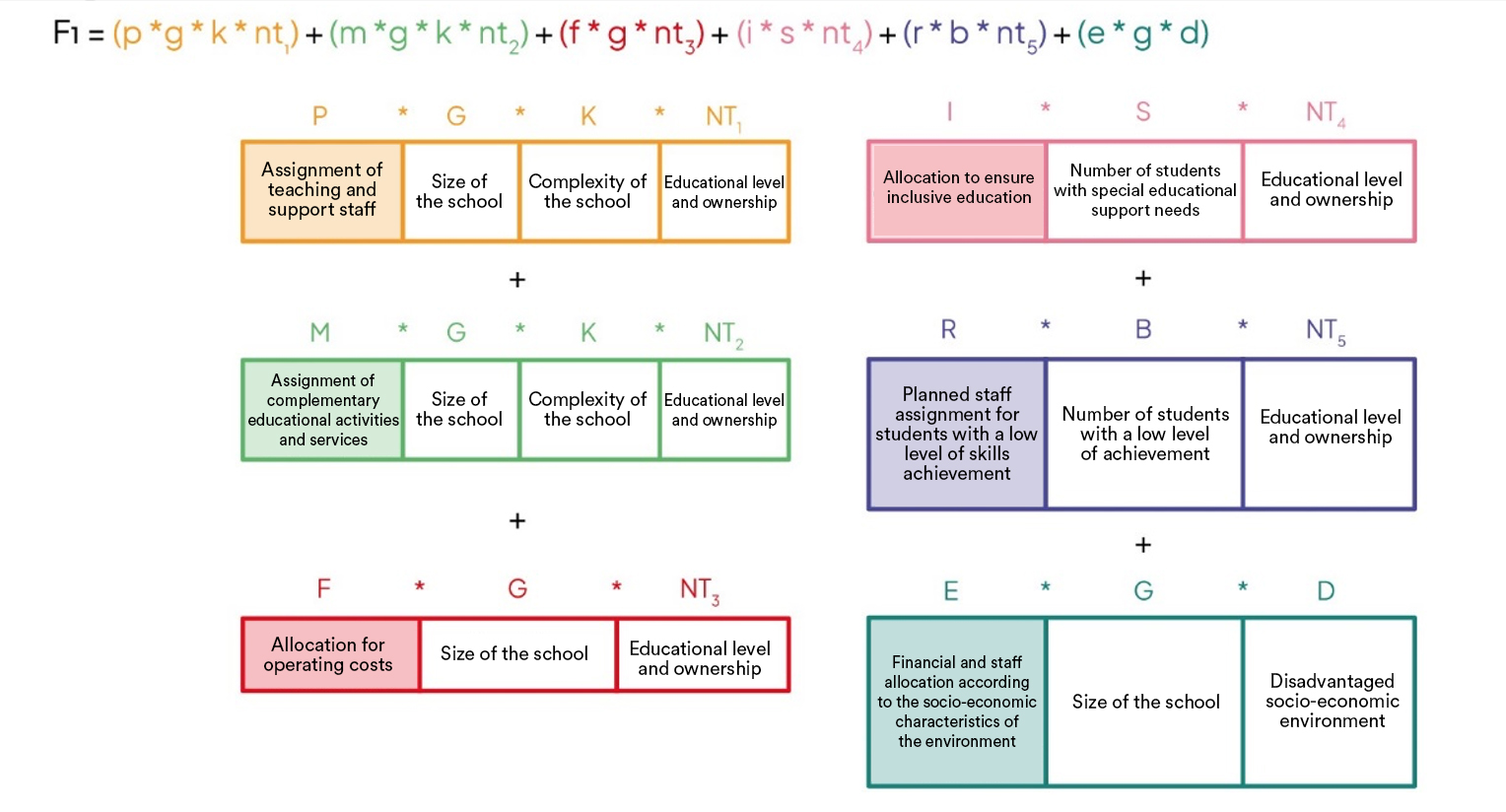FAQS: formula funding, explained
11/11/2021

The equity formula is a proposal for a new distribution system that acknowledges that not all schools have the same needs and adjusts funds according to the complexity of each school or college. In other words, it is a system that allocates more to schools that are in need of more. We are therefore proposing a necessary reformulation of the funding system which addresses a key challenge for the education system: to improve the equity of the system according to the diversity of schools’ needs.
The overall objective of this proposal is to open the debate on the viability of a formula funding system in Catalonia based on a technical, specific and applicable proposal. But what exactly are the key aspects of the new funding model and why is it better?
1. What is formula funding (FF)?
FF is a model to determine the distribution of funds among schools taking into consideration some of their characteristics and particularities. The majority of FF systems in the world incorporate an element of equity in the formula, meaning that if a school has a higher concentration of vulnerable students it will receive more funds than one that does not. Therefore, the objective of equity formula funding is to ensure that schools with a higher concentration of pupils who are socially and educationally more vulnerable receive more funds (teachers, professionals, materials, training, etc.) and are therefore able to improve their educational opportunities.
Related: Download the summary document The equity formula
2. What does our FF proposal take into consideration?
The equity formula that we propose has the following mathematical expression:
F₁ = (p * g * k * nt₁) + (m * g * k * nt2) + (f * g * nt3) + (i * s * nt4) + (r * b * nt5) + (e * g * d)
In general terms, this model is based on two main concepts:
- A basic, linear allocation for all schools, which is allocated for: a) teaching staff, and b) complementary activities and school services, as well as for operating costs (equipment, supplies, administration and service staff, etc.).
- An additional allocation, calculated on the basis of the social and educational circumstances of the school, and which increases financial and teaching staff allocation in schools: a) of greater complexity; b) with low educational outcomes; c) with more students requiring inclusive education measures; and d) located in vulnerable environments.
Related: Download the Brief report
3. But why is it more equitable than the current system?
Schools currently receive funding primarily based on their size and the number of students they have. It is true that more complex schools already receive additional funds, but this is still insufficient to meet their needs. Thus, the FF system gives greater consideration to characteristics such as the social and educational complexity of the school and its local area at the time of allocating funds.
Related: Read the Interview with Marcel Pagès, co-author of the proposal
4. Why do more complex schools require more resources than the remainder?
Students who are in a disadvantaged socio-economic situation start from a disadvantaged educational position and tend to encounter more difficulties in the learning process than children and adolescents from families with a high socio-economic status. The relationship between socio-economic status and opportunities or educational results is internationally documented (for example, in all of the PISA reports) and is explained by the fact that families with more economic resources, usually with a higher level of education, offer their children cognitive stimuli, support and guidance with learning, and access to high-value extracurricular activities which families with fewer resources are less likely to be able to offer.
More complex schools, with a concentration of disadvantaged students, require more funds to compensate for educational disadvantages
As a result, more complex schools with a concentration of disadvantaged students require more funds to be able to offer them the educational support that they need and thus compensate for the educational disadvantages and learning difficulties faced by these students.
5. Why is this model more efficient and transparent?
FF promotes efficiency in the allocation of funds insofar as it assigns the required allocations to each school according to its characteristics and, therefore, increases the impact of the investment. This model is also more transparent because the formula openly and explicitly defines what is to be financed, with what allocations and under what conditions. Accordingly, discretion is avoided and the capacity for schools to adequately forecast and plan their organisational and teaching activity is enhanced.
6. Is there a country that has already applied a similar model?
Yes, the vast majority of OECD education systems have an FF system that includes some factor of equity to allocate additional funds to more disadvantaged schools. This factor may have more or less impact on the formula depending on the case. In Europe, the cases of the United Kingdom and the Netherlands, which have been using FF models since the 1970s, are a prime example.
Related: Read the article International experiences of formula funding
7. What are we referring to when we speak about funds?
More funds for the most disadvantaged schools mean more teaching staff, but also more support professionals, specialists, reception and guidance programmes, free complementary and extracurricular activities, free school meals, parental education, and material and digital provisions, among others. These funds allow these schools to offer their students the experiences and educational opportunities that they may struggle to obtain in their family or community environment.
8. What investment is required to implement FF in Catalonia?
It would be necessary to commit to implementing the equity FF in a scenario where full coverage of the cost of the school placement and complete absence of copayments from the families is guaranteed. Implementing the proposed formula in this scenario would allow for a combination of the two objectives of equity and free education, and would have a budgetary impact of €1,622 million. It would mean transitioning from an educational expenditure of 3.6% to 4.3% as a percentage of GDP.
A first step along these lines would be to apply the equity formula in an “assurance” scenario in which social and educational inequalities between schools and colleges are largely rectified, whereby no school – not even those with less complexity – would revert back to the resources it currently receives. In this case, the investment required would be €643 million, equivalent to an educational expenditure of 3.9% as a percentage of GDP.
Related: Download the summary document The equity formula
9. And is there a budget to finance this new model?
Implementing equity formula funding in Catalonia in a scenario where more disadvantaged schools receive more resources than at present and the non-disadvantaged schools maintain their allocations could account for an investment of almost €600 million, which would mean an increase of 15% in current public expenditure on schools.
A large proportion of the funds for the new funding model are already in place. What is required is to maintain them and redistribute them in a more equitable fashion.
By way of comparison, this amount is quite close to the extraordinary expenditure that the Catalan Ministry of Education made in the 2020-21and 2021-22 academic years to respond to the Covid-19 crisis (more teachers and education professionals, digital resources, educational and community support, free school meals, etc.), which is an expenditure of around €580 million. Therefore, a large proportion of the resources for the new funding model are already in place. What is required is to maintain them and redistribute them in a more equitable fashion among schools and education settings.
10. Would government-subsidised schools also receive more funds?
The equity formula that we are proposing is aimed at funding all schools in the education system in Catalonia. In other words, the change in the funding distribution model is proposed on the basis of the social and educational characteristics of the schools, not their ownership. Therefore, with the application of the formula, government-subsidised schools with higher complexity, low educational outcomes, more students with intensive educational support and located in vulnerable environments would receive more resources than they currently do, in exactly the same way as public schools.
11. Does FF replace other programmes to support disadvantaged schools and environments?
Not necessarily. In any event, in view of the fact that FF would affect the distribution of the bulk of the budget allocated to schools and that under the new model disadvantaged schools would receive considerably more funds than they do presently, it would indeed be necessary to review the focus and scope of other existing or planned formulas to allocate additional funds to the most vulnerable schools and education settings.
Some scholarship or grant programmes for extracurricular activities, extraordinary resources for schools in specific spheres (digital, social and emotional, guidance, etc.), financial supplements per pupil with special educational needs provided for in the new Admission Decree 11/2021 or a share of the financial and professional resources included in the Plan for the Improvement of Educational Opportunities (2020, 2021) should be reconsidered depending on how progress is made in other application scenarios of the funding formula.
12. What level of independence would schools have when it comes to deciding how to receive and utilise this new funding?
The equity FF allocates more resources to schools that need them the most, some in the form of provision of teaching staff, others in the form of financial allocation. In any event, FF gives schools a degree of independence so they can define what kinds of resources they need and how to utilise them in practice. What this degree of independence should be and what the mechanisms of accountability for the use of funding by the schools should be are issues that need to be addressed in the very framework for the design and planning of any FF model. An instrument such as the programme contract can be very useful when it comes to implementing shared responsibility agreements between schools and the Catalan Ministry of Education with regard to capitalising on FF.
13. How is the formula expressed and what are main factors to it?
The FF model that we are proposing is embodied in this algebraic expression:

Do you want to find out more about the formula funding proposal for Catalonia?
- Read the summary document of the report
- Download the full report
- Read the interview with Marcel Pagès
- Retrieve the report presentation
